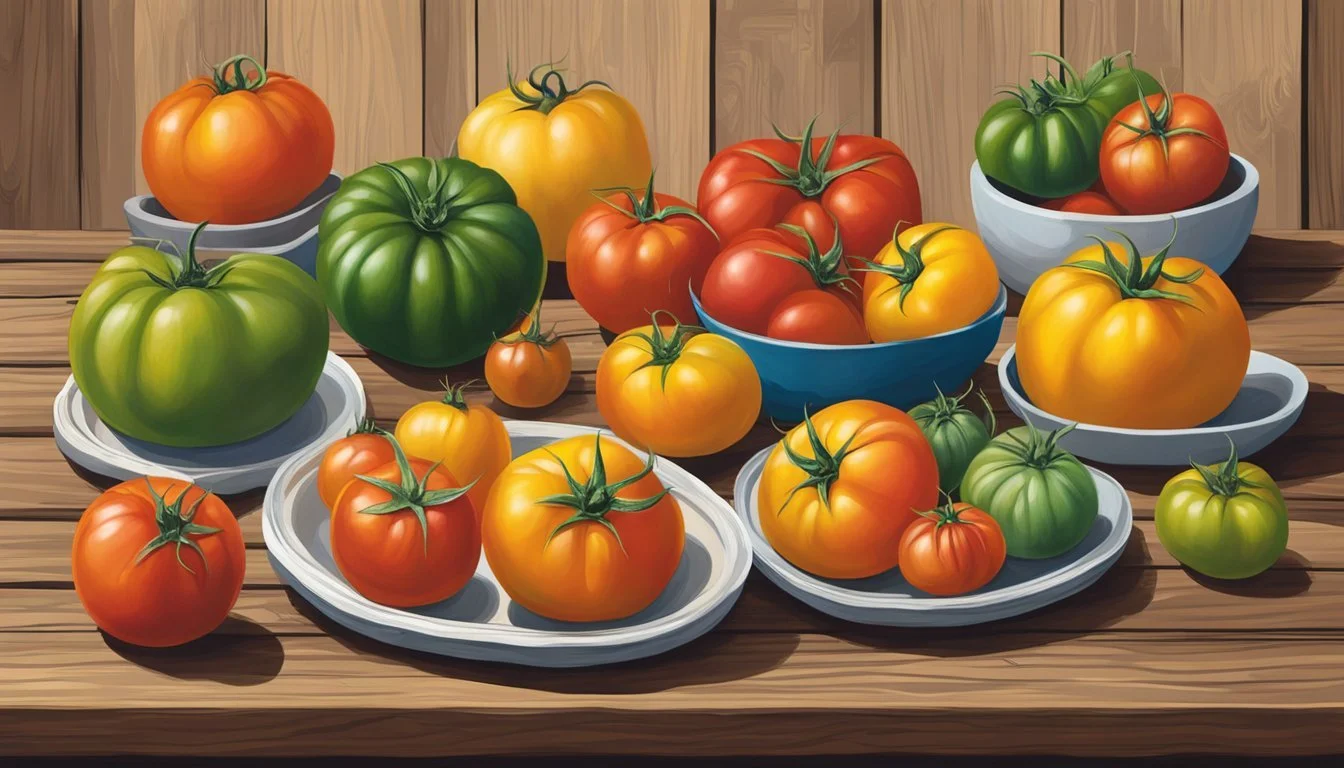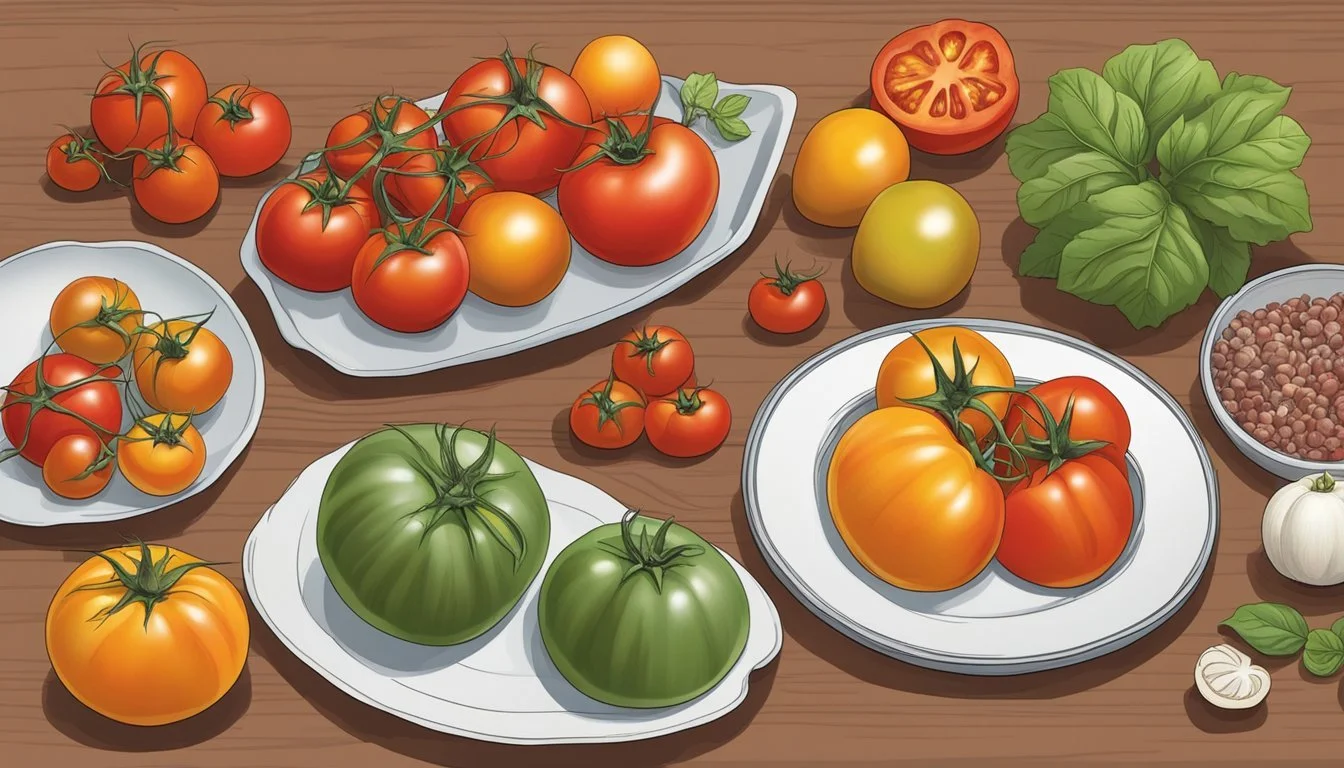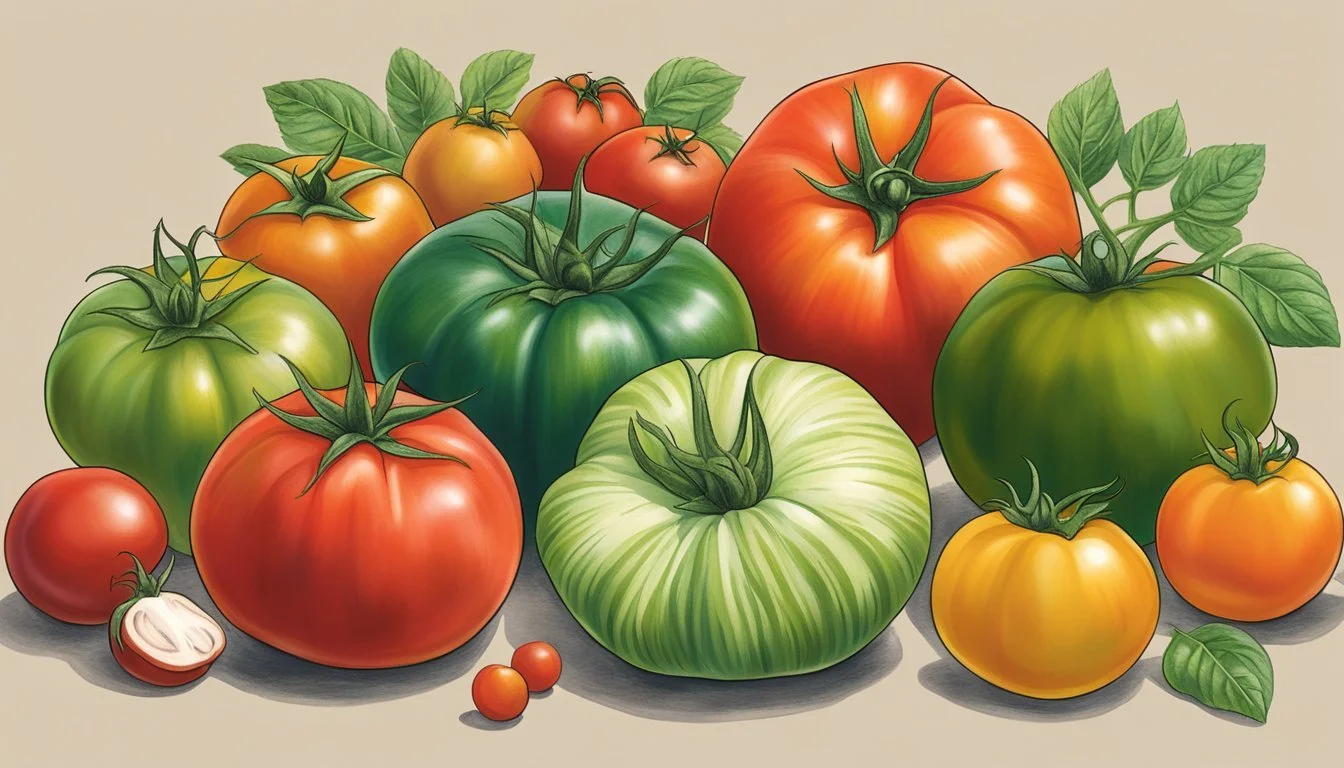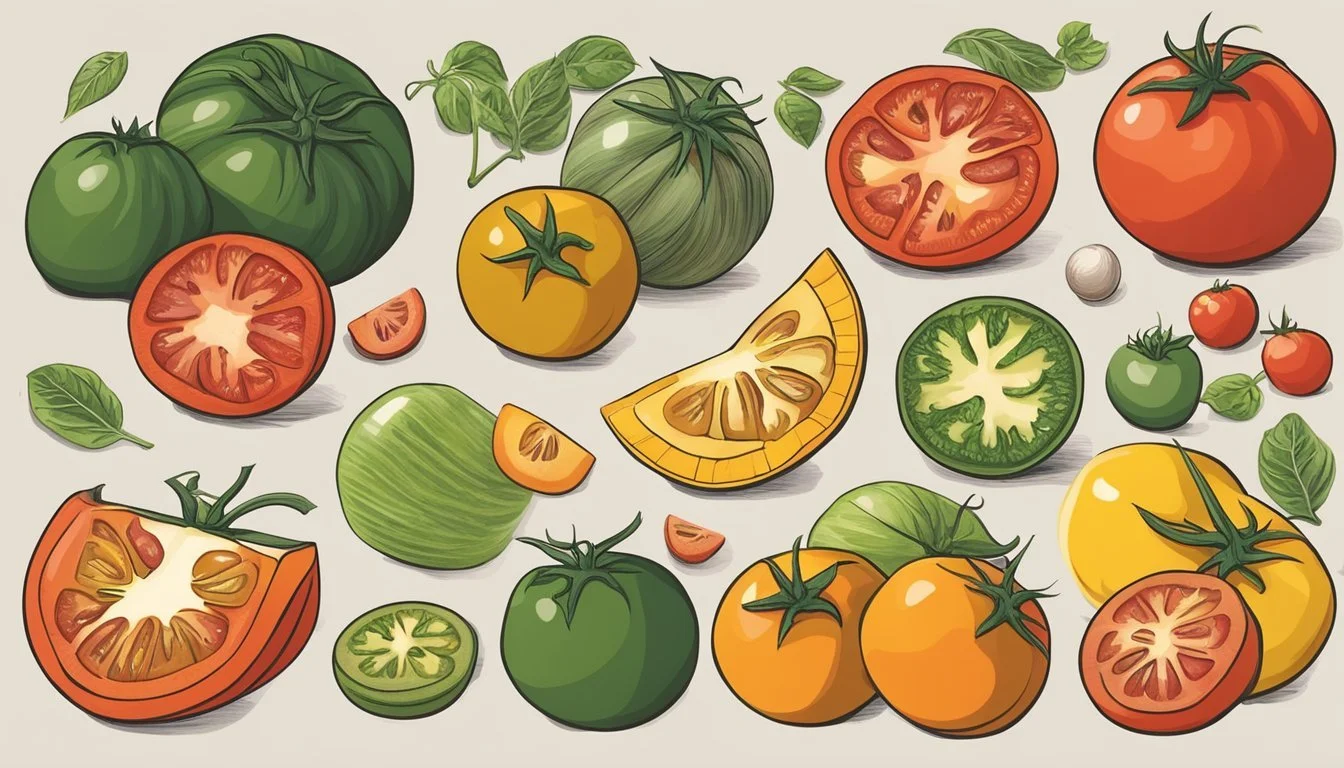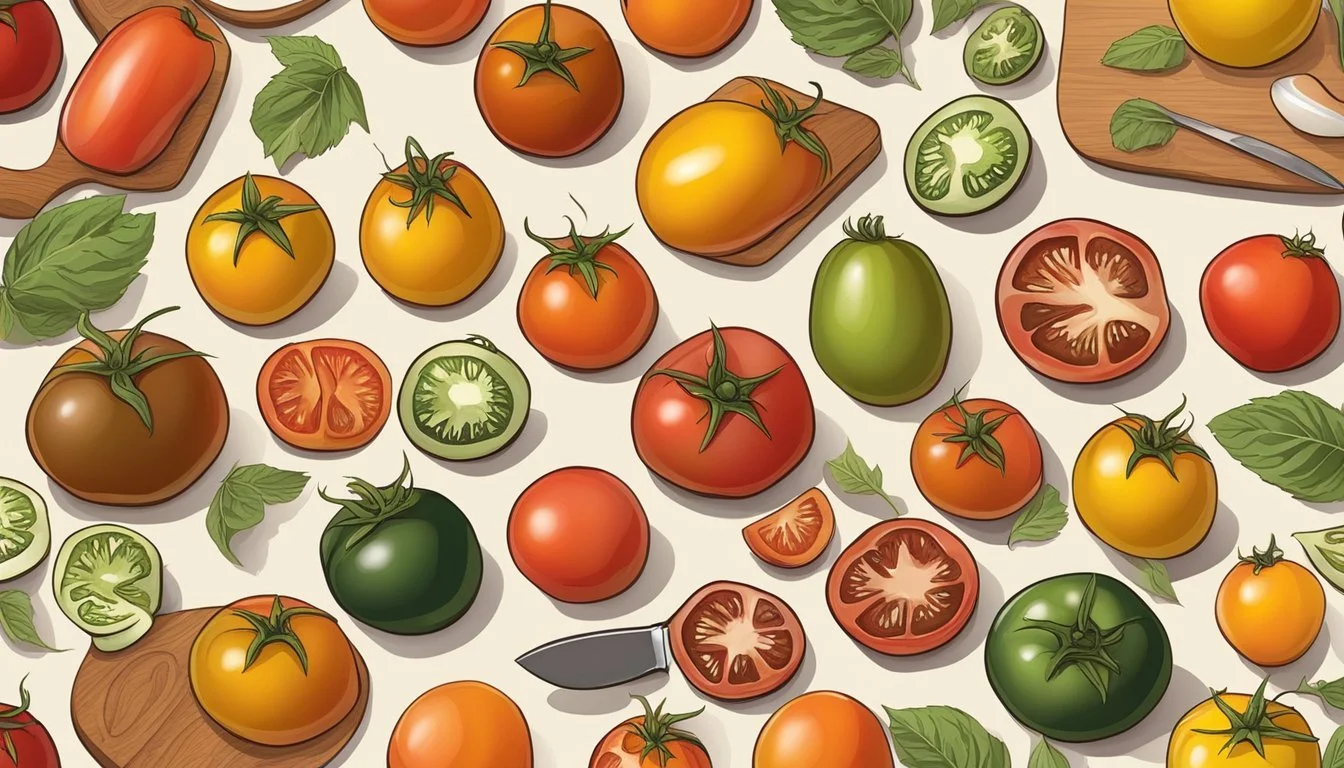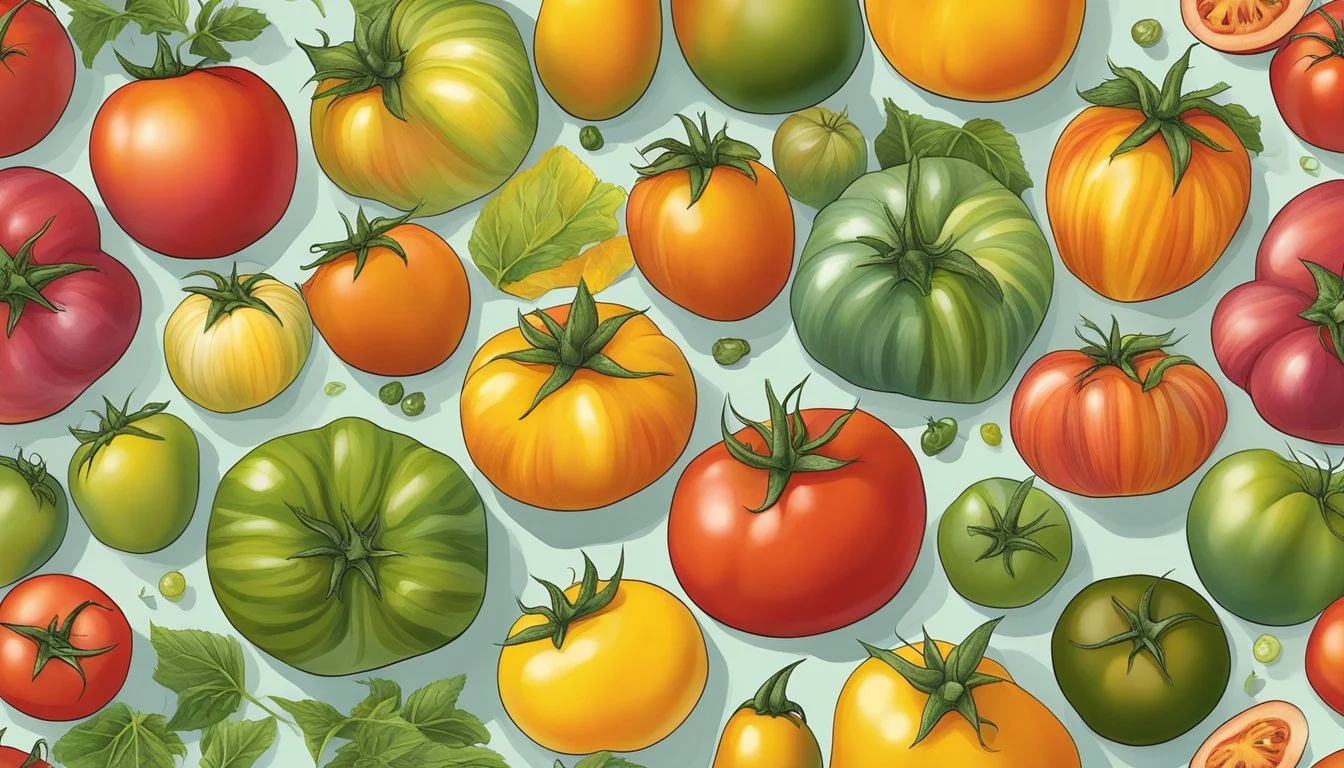Heirloom Tomatoes Substitutes
Best Alternatives for Every Recipe
Heirloom tomatoes are a cherished variety known for their rich flavors and diverse colors. However, sometimes these gems can be hard to find or out of season. In such cases, several substitutes can effectively fill the gap, ensuring your recipes don't miss out on flavor and texture.
Cherry tomatoes are a popular choice, appreciated for their sweet taste and handy size. Roma tomatoes, with their denser flesh and fewer seeds, make an excellent substitute for dishes requiring a more robust tomato base. Another viable option is beefsteak tomatoes, whose large size and juicy interior can mimic the qualities of heirloom tomatoes quite well.
For those looking for something slightly different, green tomatoes and vine tomatoes offer unique flavors and can be used creatively in various recipes. Each of these substitutes brings its own benefits and can easily adapt to recipes calling for heirloom tomatoes, making them versatile solutions in the kitchen.
Understanding Heirloom Tomatoes
Heirloom tomatoes are prized for their unique flavors, diverse varieties, and historical significance. They play essential roles in both fresh and cooked dishes, offering unparalleled taste and culinary versatility.
History and Characteristics
Heirloom tomatoes are open-pollinated varieties, meaning they rely on natural pollination by insects, birds, or wind. This results in seeds that produce plants true to the parent type. Heirlooms have been cultivated for at least 40 to 50 years, often handed down through generations.
These tomatoes come in a wide range of shapes, sizes, and colors, from deep reds and purples to vibrant yellows and greens. Their flavors can range from sweet and mild to rich and tangy.
Culinary Uses
Heirloom tomatoes shine in both fresh and cooked applications. They are popular in salads, sandwiches, and bruschetta due to their superior taste and texture. Their complex flavors also make them ideal for sauces and soups.
When used in tomato sauce or pasta sauce, heirlooms provide a depth of flavor that is hard to match with hybrid varieties. They also excel in baked dishes like savory tomato pies, where their juiciness and taste can be fully appreciated.
Reasons for Substituting Heirloom Tomatoes
Heirloom tomatoes, prized for their unique flavors and textures, often need substitutes for various pragmatic reasons. These include challenges related to their availability and compliance with specific dietary restrictions.
Availability and Seasonality
Heirloom tomatoes are typically available only during certain seasons and in specific climates. Their limited availability is because they are not grown in the same quantities as commercial varieties. This means that outside of their peak season, which is usually summer, finding heirloom tomatoes can be quite challenging.
Additionally, weather conditions can affect their yield. For instance, heirloom tomatoes need a warm climate with plenty of sunlight to flourish. In regions where the climate does not support such conditions, they might not be available at all. Thus, substitutes like cherry tomatoes, grape tomatoes, or beefsteak tomatoes become essential for maintaining consistency in recipes throughout the year.
Dietary Restrictions
Food allergies and dietary needs can also necessitate the substitution of heirloom tomatoes. While rare, some individuals might be allergic to heirloom tomatoes specifically, necessitating an alternative like green tomatoes or vine tomatoes, which might not trigger the same reaction.
Moreover, certain dietary plans may require avoiding heirloom tomatoes due to their carbohydrate content or acidity levels. For instance, in low-acid diets, tomatoes with a higher acidity like many heirlooms might need to be replaced with less acidic options. Similarly, those on low-FODMAP diets might have specific requirements that certain heirloom tomatoes do not meet.
Overall, understanding the specific dietary needs can guide one to choose the appropriate substitutes, ensuring health and dietary compliance without compromising the essence of the dish.
Popular Heirloom Tomato Substitutes
Several alternatives can replace heirloom tomatoes in various culinary applications. These substitutes include common tomato variants, non-tomato fruit options, and vegetable alternatives.
Common Tomato Variants
Cherry tomatoes, grape tomatoes, and Roma tomatoes are excellent substitutes for heirloom tomatoes. They possess a sweet and tangy flavor suitable for snacking, salads, and sauces.
Cherry tomatoes are small, juicy, and ideal for fresh consumption. Grape tomatoes offer similar uses but with a firmer texture. Roma tomatoes are less juicy and have fewer seeds, making them perfect for sauces and purees.
Beefsteak tomatoes are among the largest, boasting a rich taste useful for sandwiches and grilling. Campari tomatoes are sweet, low in acidity, and great for fresh dishes.
Non-Tomato Fruit Substitutes
Fruits like mango and tamarind paste provide unique flavors that can stand in for tomatoes in certain recipes.
Mangoes bring a sweet, slightly tangy taste that works well in salsas or chutneys.
Tamarind paste provides a sour tang that mimics the acidity of tomatoes, useful in stews and sauces.
Amla berries, similar in appearance to green tomatoes, offer a tart flavor beneficial in curries or chutneys.
Vegetable Alternatives
For those avoiding tomatoes, vegetables like red bell peppers, eggplant, and pumpkin offer viable alternatives.
Red bell peppers have a sweet flavor and vibrant color, making them suitable for salads and cooking, often used to replicate the look of tomatoes.
Eggplant has a meaty texture that grills well and can be used in ratatouille or similar dishes.
Pumpkin is versatile, with a mild sweetness that fits both savory and sweet recipes, ideal in stews and baked goods.
Specific Substitution Recommendations
When substituting heirloom tomatoes, there are tailored options depending on the culinary use. Key considerations include the dish requirements and both the texture and flavor of the substitute.
Cooked Dishes and Sauces
For cooked dishes and tomato-based sauces, Roma tomatoes are a strong substitute due to their low moisture content, which helps create a thick sauce. Plum tomatoes are also advantageous as they have fewer seeds and more flesh, providing a similar consistency to heirloom tomatoes.
Another excellent substitute is tomato paste, which delivers a concentrated flavor and color. For a twist, consider sun-dried tomatoes for a deeper, umami flavor. In more unique recipes, pumpkin puree can be used as it offers a similar consistency and a nuanced flavor profile.
When making tomato sauce, combining vine tomatoes with a bit of ketchup or tomato paste may achieve a balanced flavor and texture.
Salads and Fresh Servings
In fresh preparations such as salads, cherry tomatoes and grape tomatoes are ideal substitutes. They offer a sweet flavor and are similar in size, making them perfect for snacking or including in salads. For a more substantial bite, beefsteak tomatoes or vine tomatoes can be used.
Cucumbers can be an innovative replacement, providing a fresh crunch, although they lack the acidity of tomatoes. Adding fresh basil can enhance the flavor profile, complementing the cucumber's texture.
In recipes where color and presentation matter, combining red bell peppers with tomatoes can simulate the visual appeal and add a slight sweetness.
By carefully selecting substitutes based on the specific requirements of a dish, achieving the desired flavor and texture can be seamless.
Adjusting Flavor Profiles
When substituting heirloom tomatoes, adjusting flavor profiles can help achieve desired taste results. This involves enhancing sweetness, adding tartness or acidity, and utilizing spices to achieve balanced flavors.
Enhancing Sweetness
To enhance sweetness, consider using balsamic vinegar or glaze. These ingredients add depth with their rich, sweet notes. Mango can also be diced and added to increase natural sweetness without being overpowering.
Olive oil can round out the flavors, providing a smooth texture that complements the sweetness. Adding a touch of salt is crucial, as it helps balance the sweetness and bring out the natural flavors of the tomatoes.
Adding Tartness or Acidity
Increasing tartness or acidity can be achieved by introducing ingredients like vinegar or lime juice. Tamarind paste is another excellent option; its tangy flavor can mimic the natural tartness in heirloom tomatoes.
Green tomatoes are naturally more acidic and can be used to replicate this flavor. A small amount of lemon juice or zest can also brighten and elevate the dish, creating a fresh and tangy profile.
Utilizing Spices
Incorporating spices such as pepper, garlic, and various herbs can help replicate the complexity of heirloom tomatoes. Black pepper adds a sharp bite, while garlic provides a rich, aromatic depth.
Basil, oregano, and thyme are herbs that pair well with tomatoes, adding layers of flavor. A mix of these spices, when balanced correctly, can enhance the overall taste and mimic the robust flavors of heirloom tomatoes.
Preservation and Storage of Substitutes
To maintain the freshness and quality of tomato substitutes, proper preservation and storage techniques are crucial.
Cherry Tomatoes: Store cherry tomatoes at room temperature in a single layer, stem-side down. If they are very ripe and starting to soften, refrigeration may prolong their shelf life.
Grape Tomatoes: Similar to cherry tomatoes, grape tomatoes also benefit from room temperature storage. Refrigeration is recommended only when they are fully ripe and need to be kept longer.
Plum Tomatoes: Store plum tomatoes in a cool, dry place away from direct sunlight. For longer storage, consider freezing them. Simply wash, dry, and place them in a freezer bag.
Beefsteak Tomatoes: Keep beefsteak tomatoes at room temperature until fully ripe. Once ripe, they can be refrigerated to extend freshness. Bring them back to room temperature before eating for the best flavor.
Vine Tomatoes: Store vine tomatoes at room temperature attached to the vine for as long as possible to maintain their flavor. When fully ripe, refrigeration is suggested for extending shelf life.
Green Tomatoes: Store green tomatoes at room temperature to allow them to ripen. For preservation, consider pickling or frying them. Green tomatoes can also be frozen whole or sliced.
Roma Tomatoes: Roma tomatoes are best stored at room temperature until they ripen. Once ripe, refrigeration can help extend their usability. They are also great for canning or making sauces, which can be stored for longer periods.
Amla Berries: Amla berries should be stored in a cool, dry place. They can be refrigerated to extend freshness or even dried and stored in airtight containers for long-term use.
Each type of substitute has specific storage needs to preserve their texture and taste. Following these guidelines ensures they remain fresh and flavorful for as long as possible.
Considerations When Choosing Substitutes
When finding substitutes for heirloom tomatoes, one should consider factors like nutritional content, texture, and visual presentation. Each of these elements can significantly impact the final dish.
Nutritional Content
The nutritional content of heirloom tomato substitutes can vary significantly. Cherry tomatoes and grape tomatoes offer similar vitamin C and antioxidant levels. Roma tomatoes have slightly lower water content, making them better for sauces. For frying, green tomatoes provide an alternative with a firm texture but may have lower lycopene levels. It's essential to choose a substitute that aligns with the desired health benefits and dietary needs.
Texture Considerations
Texture is another critical factor. When snacking or using tomatoes in fresh applications, grape tomatoes and cherry tomatoes offer a satisfying firmness. Beefsteak tomatoes, with their juicy and meaty texture, are ideal for sandwiches. For frying, green tomatoes maintain their shape and firmness. For sauces, the dense texture of Roma tomatoes helps in creating a thicker, richer sauce consistency.
Color and Presentation
Presentation matters, and the color and appearance of the tomato substitute play a significant role. Red bell peppers can mimic the red color of tomatoes while adding a distinct sweetness. Amla berries, with their resemblance to green tomatoes, can be used in dishes requiring a green hue. Pumpkins or other winter squashes offer a vibrant orange color and unique aesthetic. Selecting a substitute that complements the dish's visual appeal ensures a pleasing dining experience.
Choosing the right heirloom tomato substitute requires an understanding of nutritional content, texture, and presentation to maintain the integrity of the original dish.
Gardening Tips for Heirloom Varieties
Growing heirloom tomatoes like Cherokee Purple, Brandywine, Black Krim, and Oxheart requires specific gardening techniques. These tips cover essential aspects like soil, climate conditions, cultivation practices, and managing pests and diseases.
Soil and Climate Conditions
Soil: Heirloom tomatoes thrive in well-drained, fertile soil rich in organic matter. Ideal soil pH ranges from 6.0 to 6.8. Incorporate compost or aged manure to enhance soil fertility.
Climate: These varieties need full sun, with 6-8 hours of direct sunlight daily. Optimal growing temperatures are between 70°F to 80°F. Cooler temperatures below 55°F can stunt their growth.
Watering: Regular and consistent watering is crucial. Maintain moist soil but avoid waterlogging. Mulching helps retain moisture and control weeds.
Cultivating and Harvesting
Sowing: Start seeds indoors 6-8 weeks before the last frost date. Transplant seedlings outdoors when soil temperatures reach at least 60°F.
Spacing: Space plants 18-36 inches apart to ensure good air circulation, which helps prevent diseases.
Support: Use stakes, cages, or trellises to support the vines, especially for indeterminate types like Brandywine and Oxheart. This keeps fruits off the ground and makes harvesting easier.
Harvesting: Harvest heirloom tomatoes when they reach full color and firmness. Gently twist the fruit off the vine. Regularly harvesting ripe fruits encourages continued production.
Pests and Diseases
Pest Control: Common pests include aphids, tomato hornworms, and whiteflies. Use insecticidal soap or introduce beneficial insects like ladybugs for natural pest control.
Diseases: Heirloom tomatoes are prone to diseases like blight, fusarium wilt, and blossom end rot. Rotate crops annually to prevent soil-borne diseases. Use disease-resistant varieties like Black Krim where possible.
Monitoring: Regularly inspect plants for early signs of pest infestations or disease. Remove affected leaves and use fungicides if necessary. Maintain good garden hygiene by removing plant debris and weeds.
Proper care and attention to soil, climate, cultivation, and pest management will help you successfully grow and enjoy heirloom tomatoes in your garden.
Health Benefits and Risks
Heirloom tomatoes are often praised for their rich flavor and nutritional benefits. They are low in calories, with about 35 kcal per medium raw tomato. Heirloom tomatoes contain essential vitamins such as Vitamin C and Vitamin A, crucial for immune function and eye health.
These tomatoes also provide dietary fiber, aiding in digestion and potentially lowering the risk of heart disease. The low glycemic index (GI) of heirloom tomatoes makes them a suitable choice for individuals monitoring blood sugar levels.
Antioxidants present in heirloom tomatoes, including lycopene, have been studied for their potential anticancer properties. Lycopene is associated with reduced risks of prostate cancer and cardiovascular diseases.
On the dietary side, heirloom tomatoes are very hydrating due to their high water content. This makes them a refreshing addition to any diet, particularly in hot weather or after physical activity.
Though heirloom tomatoes are generally safe, some individuals may experience allergies or gastrointestinal discomfort. Symptoms can include itching, hives, or bloating. It is advisable to consume tomatoes in moderation if prone to digestive issues.
Overall, heirloom tomatoes are a nutritious and flavorful choice for many. Their health benefits outweigh the minor risks, making them a valuable addition to a balanced diet.


